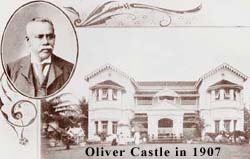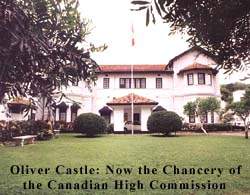 |
 9th August 1998 |
Front Page| |
Canada cares for Oliver Castle"In those days, there were chandeliers hanging from the ceiling."
The fretwork filigree of wood above the transom of each door remains but, like the doorways, has been closed up with backing boards. This is the outcome of installing that essential amenity of 20th century living in Colombo: air conditioning. The occasion that brought together the descendants of Henry Joseph Peiris of Oliver Castle and the current occupants, staff of the Canadian diplomatic mission in Sri Lanka, was historic and meaningful. It was the official recognition of this noble building as an important part of the country's heritage. The Minister of Cultural and Religious Affairs, Lakshman Jayakody and the Mayor of Colombo, Karu Jayasuriya, joined the High Commissioner of Canada, Konrad G. Sigurdson, in unveiling a plaque set into the high wall outside the Chancery. The plaque commemorates the restoration of the name of the house to Oliver Castle. A photograph hanging on the wall of the library is captioned "1951: Office of J.L.P. Peiris, 1924-1950. Oliver Castle, Gregory's Radiant." The house is one of several in Gregory's Road featured in photographs in the book Twentieth Century Impressions of Ceylon published in 1907.
Following its purchase by the Canadian Government in 1971, drastic modifications were made, including the installation of air conditioning, closing up all interior air vents, and strengthening door and window frames with steel. In his remarks before unveiling the plaque, Minister Jayakody commented that parliament has passed legislation to ensure the preservation of Colombo's "wonderful colonial houses." He acknowledged that interiors may have to be modernised but the external facades and the roof should remain intact. Without government help, this is what has happened to Oliver Castle. A photo taken 90 years ago reveals how the exterior has survived. Built in the style popular at the time, with two bay-fronted wings of two storeys, the house has lost only its frivolous touches. Gone is the open verandah with lattice screens, and also closed in is the upstairs gallery that was above it. The portico has lost its embellishments as its pillars have been plastered and painted. The awnings over the lower bay windows remain, although their charm has been lessened by dark paint work. Unusually, two new awnings have been added, over windows put into the closed verandah on either side of the entrance. The fancy fretwork border that graced the roof has vanished, in keeping with the building's sterner image. Windows are now kept firmly shut instead of raised open. The back verandah has been closed in as well, but the columns heralding entrance to the library are as proud as ever. Complete with elaborate entablature complemented with elegantly garlanded friezes, they are a contrast to the geometrical patterns of the fibrous plaster period ceiling. The floors have changed from deep set wooden boards to highly polished parquet. In the wood-panelled library, skylights set into the whitewashed wooden ceiling supplement the lighting, now the chandeliers have gone. The adjoining music room and billiard room have become office cubicles. A grand, highly varnished, wooden staircase leads to the upper floor. Its painstakingly turned balusters have leaves of carved wood in between each one. These have been backed with panels, reducing the impact of their delicate tracery. One upstairs room has a waist-high screen of wooden panels as a room divider. This was not something the Peiris family members remembered from their childhood, so it was probably part of a room wall, saved from destruction and placed there by one of the occupants from Canada. While Oliver Castle is impressive, it is what it represents that commands admiration. It was built at the behest of Joseph Henry Peiris who was born in Moratuwa in 1858. Since there were not many opportunities for ambitious Ceylonese beyond government service, Peiris became a general merchant and arrack renter. He prospered, eventually owning some of the largest arrack farms (coconut plantations) in the island. He branched out to graphite mining (plumbago) and was a pioneer in the use of mechanisation in mining. He is listed as owning nearly 3,000 acres of coconut and, later, 3,500 acres of tea and rubber plantations. He died in 1918 but his wife continued to live in the house until 1951. The house then became government property, in lieu of death duties. It is fortunate for the preservation of this heritage building that its current owners appreciate its grandeur and history. Thanks to Canada, Oliver Castle has a new lease of life. |
||
 |
More Plus * Kala Korner
Front Page| News/Comment| Editorial/Opinion| Business| Sports | Mirror Magazine |
|
 |
Please send your comments and suggestions on this web site to |
|
 The
speaker was one of the grandchildren of Henry Joseph Peiris, the first
occupant of Oliver Castle. The grandchildren (senior citizens now) and
assorted dignitaries were standing at the door of the library of the Canadian
Chancery building in Gregory's Road. "This was the dining room. And
where you see all those bookshelves used to be the doors to the rest of
the house."
The
speaker was one of the grandchildren of Henry Joseph Peiris, the first
occupant of Oliver Castle. The grandchildren (senior citizens now) and
assorted dignitaries were standing at the door of the library of the Canadian
Chancery building in Gregory's Road. "This was the dining room. And
where you see all those bookshelves used to be the doors to the rest of
the house."  Some
of those early 20th century buildings survive, more by chance than by intention.
Oliver Castle survived in part because of its sturdy construction but also
through the care lavished on it after it was leased as the Canadian mission
building in the 1950s.
Some
of those early 20th century buildings survive, more by chance than by intention.
Oliver Castle survived in part because of its sturdy construction but also
through the care lavished on it after it was leased as the Canadian mission
building in the 1950s.